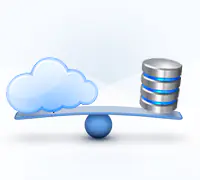
Business uptime is critical to an organization’s growth and revenue. In my earlier blog we read about the importance of Data backup and recovery and how a well drafted recovery plan helps in getting your systems up and running again quickly.
Typically businesses take a decision on an acceptable Recovery Time Objective (RTO) and a Recovery Point Objective (RPO) for their systems based on the financial impact that they may suffer due to system unavailability. There are many aspects that lead us to a selection of a data recovery mechanism and with advent of cloud base storage solutions, organizations are presented with more options for data recovery model with this in tow, let us compare data recovery in cloud with a traditional on premise datacenter.
| Factor | Cloud Data Recovery | Traditional On Premise Data Recovery |
|---|---|---|
| Ease of Getting Started |
|
|
| Simplicity |
|
|
| Time |
|
|
| Cost |
|
|
| Management Consistency |
|
|
| Scalability |
|
|
| Response Time and Latency |
|
|
| Application Compatibility |
|
|
Now since we have established that for most of the applications and requirements a cloud based data recovery service is better, let us see some options for cloud data recovery.
Managed applications and managed DR
- In this option, one puts both primary production and disaster recovery instances in cloud and have them both managed by the CSP. With this one can derive and maximize the benefits of cloud computing such as pay as you go and eliminate infrastructure investments
- Organizations choosing this option must select the CSP with due diligence and negotiate a service level agreement which is conducive for one’s business objectives
Back up to and restore from the cloud
- This option is a substitute for tape based offsite backups. In this approach the applications and data remain on premise , with data being backed up on cloud regularly
- When a disaster occurs, the data from cloud instance can be loaded on-premise to allow the systems to continue functioning
Back up to and restore to the cloud
- Here, the data is stored in the cloud, but when the disaster occurs it is not restored back on-premise, instead it is stored in virtual machines in the cloud and will start serving your business from there, which can easily be achieved with Amazon’s Elastic Compute Cloud
Replication to virtual machines in the cloud
- This approach is suitable for applications/data which are critical to a business and cannot suffer from extended downtime.
- These applications require a continuous data protection(CDP) to replicate changes in data immediately from on-premise to cloud
Cloud provides many options w.r.t your requirements and budget especially for small and medium sized businesses when compared to a traditional on premise data center. With growing adoption of cloud, we would see more customization in data storage and tight recovery time SLA’s.





